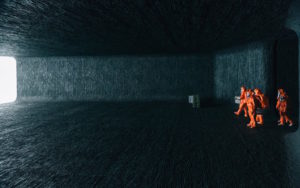
Playing with time has a big appeal for Joe Walker, editor of Arrival, the non-linear, sci-fi mystery starring Amy Adams and Jeremy Renner, as a linguist and scientist tasked with interpreting the language of alien visitors.
“We’re talking about time. That is certainly something I’ve been obsessed by in the last few films I’ve worked on,” admitted Walker. “Twelve Years a Slave was taking a linear structure and then breaking it up and turning some things into flashback, bouncing around between time frames. That felt like a great opportunity with this film.”
After the first assembly screening of the film, director Denis Villeneuve told Walker that they had to treat the film like a documentary and find the film inside. The film was based on a great script, but Walker noted that many of the scenes, such as the sequences at the lakeside, could come anywhere outside of the main narrative. It was just a question of finding the perfect place.
“We found a way to make it a real driving story just doing crosscutting and juxtaposing things that maybe were not originally intended to be put that way,” said Walker.
There was a lot of freedom in editing the film. Ultimately it is all about story and getting the right match of story and pace, while making sure all the beats landed. Sections of the film were moved around to “wrestle a huge amount of tension” out of the narrative. If there was not enough of a release or climax after restructuring, the filmmakers built new sequences to make the new order of scenes work.
One of the biggest freedoms in the editing came down to the fact that two of the main characters were non-existent during the shoot. The aliens, Abbot and Costello, were no more than a tennis ball on the end of a pole that gave the actors a place to focus. Editorial worked very closely with visual effects to develop these characters, releasing the information about these mysterious beings very “gently.” At first there were just dark shadows, shapes briefly visible in the mist.

“I think Denis is a master of that very grown-up way of exposition. You are sort of glimpsing things. You piece it together and it stimulates a lot of curiosity about what they are like. You hear them before you see them. You see the task before Louise [Adams] and it seems insurmountable,” stated Walker. “That felt right at the heart of editing. Those kinds of changes, and that molding of the story, felt very much in my court.”
Walker and Villeneuve worked together previously on Sicario and are currently working on Blade Runner 2049. Walker feels fortunate to have established the continuing collaboration because the director loves being in the edit room and is an “expert at fanning the flames of creativity in the cutting room.” Villineiuve will share an idea about a scene without necessarily specifying any of the steps Walker should take to achieve the desired outcome, giving the editor a very “passionate ownership” of his contribution to the film. For Walker, that was a very complimentary way of working.
“He is such a great director. He’s got this command of performance and of visual storytelling. He’s and expert at tension and suspense and knowing how to kind of compliment an audiences intelligence, which is exactly where I want to be,” revealed Walker.

For Walker, editing is a bit of a storytelling game of when you are parallel with the audience, and when you are ahead of them. Arrival is a complex, “densely-packed” film philosophically, linguistically and politically. The editor and director worked “shoulder to shoulder” on the editing, discussing what the problems were, and being as creative as possible in solving those problems. It took a number of test screenings and finessing the non-linear edit to ensure the audience understood what was happening, while also achieving the emotional reaction to the ending that the filmmakers desired.
“The difficulty is more than 100 years of cinema. You start with a child dying and then you cut to a grief-stricken woman. We assume a timeline from that,” shared Walker. “That’s a solid wall you really have to kick down hard. Really at the heart of shaping this story was making sure we were generous enough as storytellers to make it clear what was happening, without spelling it out in blunt terms that bang people over the head.”





